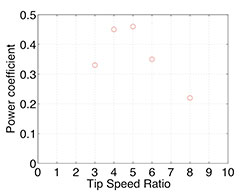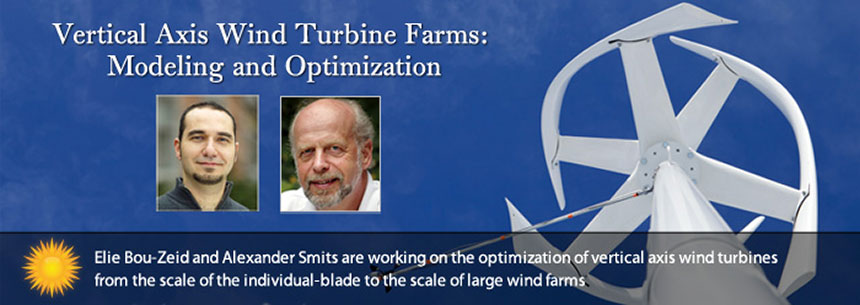Vertical Axis Wind Turbine Farms: Modeling and Optimization
2011-13 New Investigator Award


Vertical axis wind turbines (VAWTs) are proposed as an alternative to the more commonly used horizontal axis wind turbines (HAWTs) due to the potential increase in packing density (reduction in distance between turbines) that is possible with VAWTs. But for VAWTs to be more widely adopted and for their advantages to be maximized, more work is needed in the turbine and farm designs. This project aims at improving the design of VAWTS and their configurations in large farms.This work has major impacts on the adaptation and development of wind as an alternative energy source in the US and worldwide; wind is already the fastest growing energy source in the US (as a percent increase on previous installed capacity for a given source). The project team has generated an artificially thickened boundary layer in the MAE wind tunnel in order to test scale models of wind turbines. Tests of the original flow indicated that improvements were required to remove the cross-stream variations in the profile. They have now achieved a flow that closely matches the wind profile, turbulence levels, and spectrum seen in the atmospheric boundary layer. Their tests on a model VAWT in the original thick boundary layer are now being repeated and performance results are expected shortly. They have also implemented a VAWT representation (that resolves the force on each individual blade) in a large eddy simulation code and we proceeding with validation of the approach and modeling of various configurations of multiple turbines to understand their interactions and optimize farm configuration.


On the simulation side, the team implemented an actuator line model (ALM) to represent each blade of the VAWT in a large-eddy simulation code of the ABL. The ALM model computes the blade-air force interactions (the lift and drag forces on the blade) using the local air velocity at the location of the blade, the blade velocity, the blade model information, and tabulated drag and lift coefficient for that blade at the given Reynolds number from databasis develop by the Sandia National Lab. They are completing a thorough validation of the model by comparing to finer simulations that resolve the blades and to experiments. The initial results indicated that an important factor to consider is the effect of flow unsteadiness on the lift and drag coefficients. This unsteadiness delays flow separation and improves turbine performance. The team has included a model for this effect and the validation results so far are promising (see power coefficient versus tip speed ratio plot in Figure 1). They have also begun to study the flow features and the wake of a single turbine (see Figure 2) with the aim of studying multiple interacting turbines soon.


To simulate experimentally the interaction of large Vertical Axis Wind Turbines (VAWT) with the Atmospheric Boundary Layer (ABL) in the laboratory, we implement a variant of Counihan’s technique [Counihan 1969] in which a combination of a castellated barrier, elliptical vortex generators, and floor roughness elements is used to create an artificial ABL profile in a standard closed loop wind tunnel. To examine the development and formation of the artificial ABL hotwire and SPIV measurements were taken at various downstream locations with changes in wall roughness, wall type, and vortex generator arrangements. It was found possible to generate a boundary layer at Reθ∼106, with a mean velocity that followed the 1/7 power law of a neutral ABL over rural terrain and longitudinal turbulence intensities and power spectra that compare well with the data obtained for high Reynolds number flat plate turbulent boundary layers [Hultmark et al. 2010]. The results shown in Figure 3 were obtained using Stereo PIV to measure the velocity distributions across the wind tunnel at nine locations downstream of the vortex generators used to thicken the boundary layer. The lower set of profiles indicates that by doubling the number of vortex generators, the cross-stream variations were considerably reduced.


Educational Impacts
- PI Bou-Zeid has developed his course notes in CEE305 ‘Environmental Fluid Mechanics’ into chapters last year with a full chapter dedicated to wind energy. The results from this project in terms of VAWT simulations are featured in the chapter.
- In preparing the second edition of the text used in MAE 222/CE 206 (Mechanics of Fluids), co-PI Smits is extensively revising the chapter on environmental fluid mechanics to include more educational material on wind engineering.
- Co-PI Smits is hosting Mr. Abel John Buchner, a Fulbright Scholar from Monash University in Melbourne, Australia, for one year to study dynamic stall as it relates to wind turbine operation.
- Hossein Hezaveh, the Ph.D. Student working with PI Bou-Zeid on the modeling side, is an AI this year for an EPICS course where the students are developing a portable and rapidly deployable wind/solar hybrid system. PI Bou-Zeid is one of the two instructors on the course.
- PI Bou-Zeid gave an invited talk in the summer of 2012 at the “Energy Path 2012: America’s Sustainable Energy Future” conference on wind energy.
Other Outcomes
- Seyed Hossein Hezaveha and Elie Bou-Zeid “Large eddy simulations of vertical axis wind turbines to optimize farm design” Paper G24.00007, 66th Meeting of the American Physical Society Division of Fluid Dynamics, Pittsburgh, PA, MD, November 24-26, 2013.
- Tristen Hohman, Alexander Smits, Luigi Martinelli “Interaction of an Artificially Thickened Boundary Layer with a Vertically Mounted Pitching Airfoil,” Paper A27.00009, 64th Meeting of the American Physical Society Division of Fluid Dynamics, Baltimore, MD, November 20-22, 2011.
- Hohman, T., Smits, A. J. and Martinelli, L., “Wind tunnel simulation of the atmospheric boundary layer.” Paper L1.00008, 65th Meeting of the American Physical Society Division of Fluid Dynamics, San Diego, CA, November 18-20, 2012.
- Tristen Hohman, Alexander Smits, Luigi Martinelli, Wind Tunnel Simulation of the Atmospheric Boundary Layer. Paper D1.00003, 66th Meeting of the American Physical Society Division of Fluid Dynamics, Pittsburgh, PA, November 24-26, 2013.
- Related funding has been secured through ACEE “Development of Optimal Aerodynamic Shapes for Stall Delay and Mitigation in Wind Turbine Applications,” (9/2012 – 8/2013, $99,957). Additional funding will be sought through NSF.
- We have established a MOU between Princeton University and the National Wind Resource Center (NWRC), a Texas nonprofit corporation, effective November 15, 2012. This agreement was executed to pursue collaborative opportunities in wind power research and development.


Participating Department
- Civil and Environmental Engineering
- Mechanical and Aerospace Engineering
- Geophysical Fluid Dynamics Laboratory
Collaborating Institutions
Participants
Research Associates
- Chris Golaz
Graduate Students
- Seyyed Hossein Hezaveh
- Tristen Hohman
Undergraduate Students
- Kathleen Cavanagh ’14
- Claudia Vargas ’13






